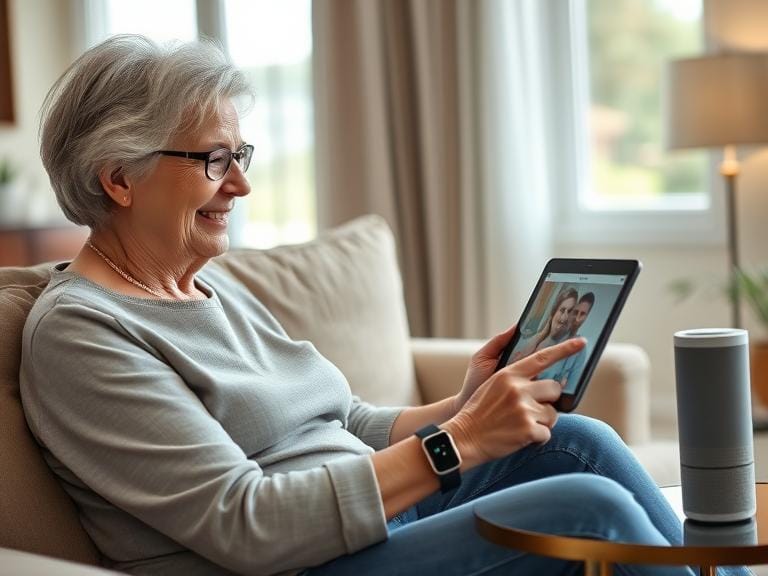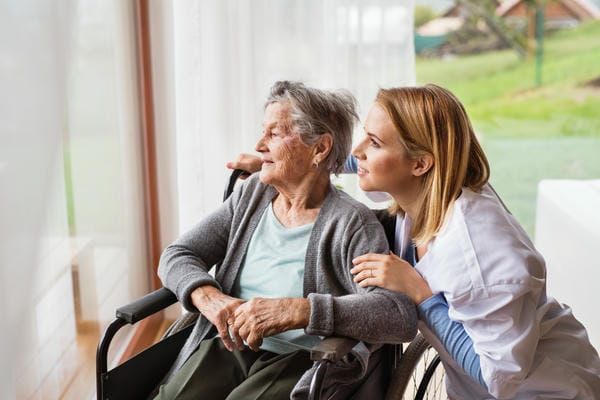In the quiet corner of her living room, 78-year-old Eleanor taps the screen of her tablet and smiles as her granddaughter’s face appears. “I never thought I’d be doing video calls at my age,” she tells me, “but now I can’t imagine life without it.” What was once an intimidating piece of technology has become Eleanor’s lifeline to family, healthcare providers, and a world beyond her four walls.
Eleanor’s story isn’t unique. Across the country, seniors are discovering how technology can transform their daily lives, extending independence and enhancing quality of life in ways previous generations could only imagine. While aging inevitably brings certain challenges, today’s technological innovations offer unprecedented support for the skills needed to maintain autonomy and dignity.
The intersection of aging and technology represents one of the most promising frontiers in elder care—a space where thoughtful innovation meets genuine human need. As our population ages, with adults over 65 representing the fastest-growing demographic in many developed nations, the importance of supporting daily living skills cannot be overstated. These fundamental abilities—from managing medications to maintaining social connections—form the foundation of independence and well-being in later life.
Understanding Daily Living Skills for Seniors
“The things most people take for granted are often the very things that determine whether a senior can remain independent,” explains Dr. Maria Hernandez, a geriatric specialist I consulted for this article. “Daily living skills encompass everything from basic self-care to complex household management tasks.”
These skills typically fall into several categories: physical mobility and self-care (bathing, dressing, walking); instrumental activities (cooking, cleaning, managing finances); communication abilities; and cognitive functions that support decision-making and problem-solving. The gradual decline in some of these abilities represents one of the most challenging aspects of aging.
Physical changes like decreased muscle strength, joint stiffness, and sensory impairments can make previously simple tasks like opening medication bottles or climbing stairs increasingly difficult. Cognitive changes may affect memory, processing speed, and the ability to learn new skills—particularly challenging in our rapidly evolving technological landscape. Sensory changes, especially in vision and hearing, can further complicate interaction with both the physical and digital worlds.
“I used to pride myself on my independence,” shares Robert, 82, whom I met at a senior technology workshop. “Then my arthritis got worse, and suddenly I couldn’t do basic things like turn on lamps or adjust my thermostat easily. That’s when my daughter suggested smart home technology. Now I control everything with my voice. It’s given me back a sense of control I thought I’d lost forever.”
Key Areas Where Technology Can Help
Mobility and Safety
Falls represent one of the most serious threats to senior independence, with the CDC reporting that one in four Americans age 65+ falls each year. Technology has responded with innovative solutions that detect, prevent, and mitigate fall risk.
Wearable devices like medical alert pendants have evolved from simple “help buttons” to sophisticated systems with automatic fall detection, GPS tracking, and direct communication capabilities. Many can detect unusual movements or impacts and automatically alert emergency services or family members if the wearer is unresponsive.
“The peace of mind is as valuable as the technology itself,” explains Marilyn, 75, who wears a discreet pendant after a fall last year left her stranded on her kitchen floor for hours. “I don’t worry about being alone anymore, and neither does my son.”
Smart home systems have revolutionized home safety with automated lighting that activates when sensors detect movement—particularly valuable for nighttime bathroom trips when fall risk is highest. Voice-activated controls enable seniors with mobility limitations to adjust thermostats, lock doors, or control appliances without physical effort.
GPS navigation tools specially designed for seniors help address the anxiety many feel about getting lost or disoriented when traveling independently. These applications often feature simplified interfaces, clear directions, and emergency contact functions.
Health and Wellness
Healthcare delivery has undergone a transformation with telehealth platforms that bring medical expertise directly into seniors’ homes. The pandemic accelerated adoption of these services, with many seniors discovering they could manage routine appointments, consultations, and even some examinations without the physical and logistical challenges of in-person visits.
“I used to miss appointments because driving to the doctor’s office became too difficult,” says Thomas, 84. “Now I see my cardiologist monthly through my computer. He monitors my vitals through my smartwatch, adjusts my medications, and I never have to leave home.”
Medication management—often complex for seniors with multiple prescriptions—has benefited tremendously from technological innovation. Smart pill dispensers can be programmed to release the correct medications at prescribed times, with alerts and notifications if doses are missed. Companion applications track medication history, provide refill reminders, and can share information with healthcare providers for better coordinated care.
Wearable health monitors have evolved beyond simple step counters to sophisticated devices that track heart rate, blood pressure, sleep patterns, and even detect atrial fibrillation or other cardiac irregularities. For seniors managing chronic conditions like diabetes, devices that continuously monitor glucose levels and transmit data to smartphones provide reassurance and potentially life-saving early warnings.
Communication and Social Connection
Perhaps no area has been more profoundly affected by technology than social connection—a critical component of mental and physical health for seniors. The isolation that often accompanies aging can lead to depression, cognitive decline, and poorer health outcomes across all measures.
Video calling platforms have transformed how families stay connected across distances. User-friendly interfaces designed specifically for seniors have reduced technical barriers, allowing even those with limited digital experience to maintain face-to-face connections with loved ones.
“My grandchildren live across the country,” Eleanor tells me. “Before I learned to use video calls, I was missing their childhoods. Now I read them bedtime stories three times a week and feel like I’m part of their lives again.”
Social media platforms with senior-friendly designs help maintain connections to broader communities. Groups focused on shared interests, former careers, or health conditions provide valuable peer support and combat the isolation that often accompanies aging.
Voice assistants represent one of the most accessible technological advances for seniors. Devices like Amazon’s Echo or Google Home respond to natural speech patterns, requiring no technical expertise to operate. Beyond simple information requests, these devices can make phone calls, send messages, play music, read books aloud, and control other smart home devices—all through voice commands.
Cognitive Support
Maintaining cognitive function ranks among the top concerns for many aging adults. Technology offers innovative approaches to brain health through engaging applications designed to exercise different cognitive domains.
Brain-training apps and games target specific cognitive functions like memory, attention, and processing speed through scientifically designed exercises disguised as entertaining activities. Many offer progressive difficulty levels and track performance over time, providing motivation through measurable improvement.
Digital reminder systems help compensate for normal age-related memory changes, providing alerts for appointments, medication schedules, and important tasks. More sophisticated systems can detect patterns of daily living and provide prompts when routines are disrupted—a particular benefit for those experiencing mild cognitive impairment.
Virtual reality (VR) technologies are showing promise in cognitive therapy, offering immersive experiences that stimulate multiple brain regions simultaneously. From virtual travel experiences that provide cognitive stimulation and emotional engagement to structured therapeutic programs, VR opens new possibilities for maintaining mental acuity.
Household Management
Daily household tasks often become challenging as physical abilities change. Smart home technologies offer practical solutions that extend independence in surprising ways.
Smart appliances with safety features like automatic shut-offs prevent accidents while simplifying operation. Voice-controlled cooking appliances eliminate the need to manipulate small controls or remember complex sequences of buttons. Robotic vacuum cleaners maintain cleaner living environments without physical exertion.
Online grocery delivery services and meal planning tools have revolutionized nutrition management for seniors with limited mobility. Applications that remember preferences, dietary restrictions, and past purchases simplify the ordering process, while delivery eliminates the physical challenges of shopping.
Financial management applications designed with seniors in mind help maintain control over personal finances with features like automatic bill payment, budget tracking, and fraud alerts. These tools often include simplified interfaces and options for family oversight when appropriate.
Benefits of Technology for Seniors
The advantages of technological adoption extend far beyond convenience, touching fundamental aspects of well-being and quality of life.
Independence represents the most significant benefit for many seniors. “Technology doesn’t just help me do things,” explains Robert. “It helps me continue being myself.” This maintenance of autonomy directly impacts psychological well-being, preserving dignity and identity even as physical abilities change.
Enhanced safety provides reassurance to both seniors and their families. Fall detection systems, emergency response technology, and remote monitoring create layers of protection that enable continued independent living even as risk factors increase.
Health outcomes improve through better medication compliance, increased physical activity motivated by fitness trackers, improved nutrition through meal delivery services, and earlier intervention when health monitoring devices detect concerning changes.
Social connection, perhaps the most underappreciated determinant of health in older adults, flourishes through communication technologies that overcome physical barriers to interaction. Regular social engagement has been linked to slower cognitive decline, reduced depression, and even longer lifespans.
Daily task simplification conserves energy and reduces frustration, allowing seniors to focus on activities that bring meaning and joy rather than struggling with routine chores. This reallocation of limited energy and attention can significantly enhance quality of life.
Challenges and Considerations
Despite its potential benefits, technology adoption among seniors faces significant barriers that must be addressed for equitable access and meaningful impact.
Accessibility remains a primary concern, with many technologies designed without consideration for age-related changes in vision, hearing, dexterity, and cognitive processing. Interfaces with small text, low contrast, complex navigation, or requiring precise motor control present substantial obstacles for many older adults.
Digital literacy varies tremendously among seniors, with many having limited exposure to technological concepts that younger generations take for granted. Learning curves can be steep, and without appropriate support, many give up before experiencing benefits.
Cost presents a very real barrier, with many seniors living on fixed incomes that leave little room for technology investments. The monthly subscription costs associated with many services compound this challenge, creating ongoing financial burdens.
Privacy and security concerns weigh heavily on many seniors’ minds, often with good reason. Older adults represent prime targets for technology-based scams, and many lack the background knowledge to evaluate security risks or implement protective measures.
Strategies for Successful Technology Adoption
Successful technology integration requires thoughtful approaches that address the unique needs and concerns of older adults.
“The key is meeting seniors where they are,” explains Liam Chen, who runs a technology training program at a local senior center. “We start with their specific needs—maybe they want to see photos of grandchildren or have an easier way to turn off lights at night—and build from there. Starting with clear benefits rather than the technology itself makes all the difference.”
Tailored training programs that accommodate different learning styles and paces prove most effective. One-on-one instruction, written materials with large print, hands-on practice sessions, and repetition of key concepts help overcome initial barriers. Programs that build confidence through early successes before introducing more complex functions maintain motivation through the learning process.
Family involvement can significantly enhance adoption success. When family members understand both the technology and the senior’s specific needs and challenges, they can provide ongoing support and troubleshooting. Intergenerational technology sharing often creates meaningful connection opportunities while transferring knowledge naturally.
Selecting appropriate technology represents perhaps the most critical success factor. Devices and applications designed specifically for seniors typically feature larger buttons, simplified navigation, clear instructions, and fewer unnecessary features. Voice-activated systems often provide the most accessible entry point by eliminating complex interfaces entirely.
Community partnerships expand access and support. Libraries, senior centers, and community organizations increasingly offer technology loan programs, training workshops, and ongoing assistance. These resources prove particularly valuable for seniors with limited financial resources or without nearby family support.
Case Studies and Examples
Across the country, seniors are discovering how technology enhances independence through both individual adoption and community-based initiatives.
The Virtual Senior Center program in New York City connects homebound seniors through video-conferencing technology, offering virtual classes, discussion groups, and social activities. Participants report significant decreases in loneliness and depression, with many forming meaningful friendships through the digital platform.
In San Diego, a pilot program providing seniors with simplified tablets pre-loaded with healthcare applications, video calling capabilities, and brain games demonstrated significant improvements in medication adherence and reported quality of life after just three months. Participants especially valued the ability to attend virtual doctor appointments without transportation challenges.
Individual success stories abound. Margaret, 86, uses a combination of smart speakers, automated lighting, and a video doorbell to manage her home despite advancing Parkinson’s disease. “Before these technologies, I was facing a move to assisted living,” she explains. “Now I can stay in my home of forty years, which means everything to me.”
James, 79, a retired teacher living in rural Colorado, maintains connections with former students and colleagues through a senior-focused social media platform. “Living thirty miles from town, especially in winter, you can get very isolated,” he says. “My online community keeps me engaged and thinking. We have wonderful discussions about books, current events—it’s like having a coffeehouse conversation without leaving home.”
Future Trends in Technology for Seniors
The future promises even more transformative technologies designed with seniors’ needs in mind.
Advancements in artificial intelligence and natural language processing will make voice-activated systems increasingly intuitive and capable. Systems that learn individual preferences, anticipate needs, and adapt to changing abilities will provide more personalized support.
Robotics for companionship and caregiving tasks shows particular promise. From robotic pets that provide emotional connection without the care requirements of living animals to assistance robots that can retrieve items, provide physical support for movement, or even assist with personal care tasks, these technologies could revolutionize aging in place.
Wearable technologies continue advancing beyond current capabilities. Clothing with embedded sensors will monitor health metrics unobtrusively, while exoskeleton developments may eventually provide mobility support for weakened muscles or joints.
Personalization represents the most significant trend, with technology increasingly tailored to individual needs, preferences, and circumstances. As data collection and analysis capabilities advance, technology will adapt to users rather than requiring users to adapt to technology—a critical shift for widespread adoption among diverse senior populations.
Conclusion
Technology alone cannot address all the challenges of aging, but thoughtfully applied innovations can significantly enhance independence, safety, health, and connection for seniors navigating the complex journey of later life.
As Eleanor puts it: “I’m still me—still wanting to learn, connect, and live fully. Technology helps me do that despite the limitations my body sometimes tries to impose.”
The most successful approaches recognize that technology serves as a tool rather than a solution in itself—a means of supporting the fundamental human needs that remain constant throughout the lifespan. When designed with seniors’ specific circumstances in mind and implemented with appropriate training and support, technology can indeed transform the experience of aging.
For families, caregivers, and seniors themselves, exploring technological options represents an investment in continued independence and quality of life. For society more broadly, supporting equitable access to these tools recognizes the inherent dignity and ongoing contributions of our older citizens.
As our population ages, leveraging technology to enhance daily living skills for seniors isn’t just a matter of convenience—it’s an essential strategy for creating communities where meaningful aging in place becomes possible for more people. The future of aging looks increasingly digital, and increasingly bright.





